Crochet this beach coverup pattern from two granny stitch hexagons! You'll find this method of construction fun and easy to make the perfect poolside topper or lightweight pullover sweater.
The free hexagon coverup pattern is below or purchase the ad-free, printable PDF.
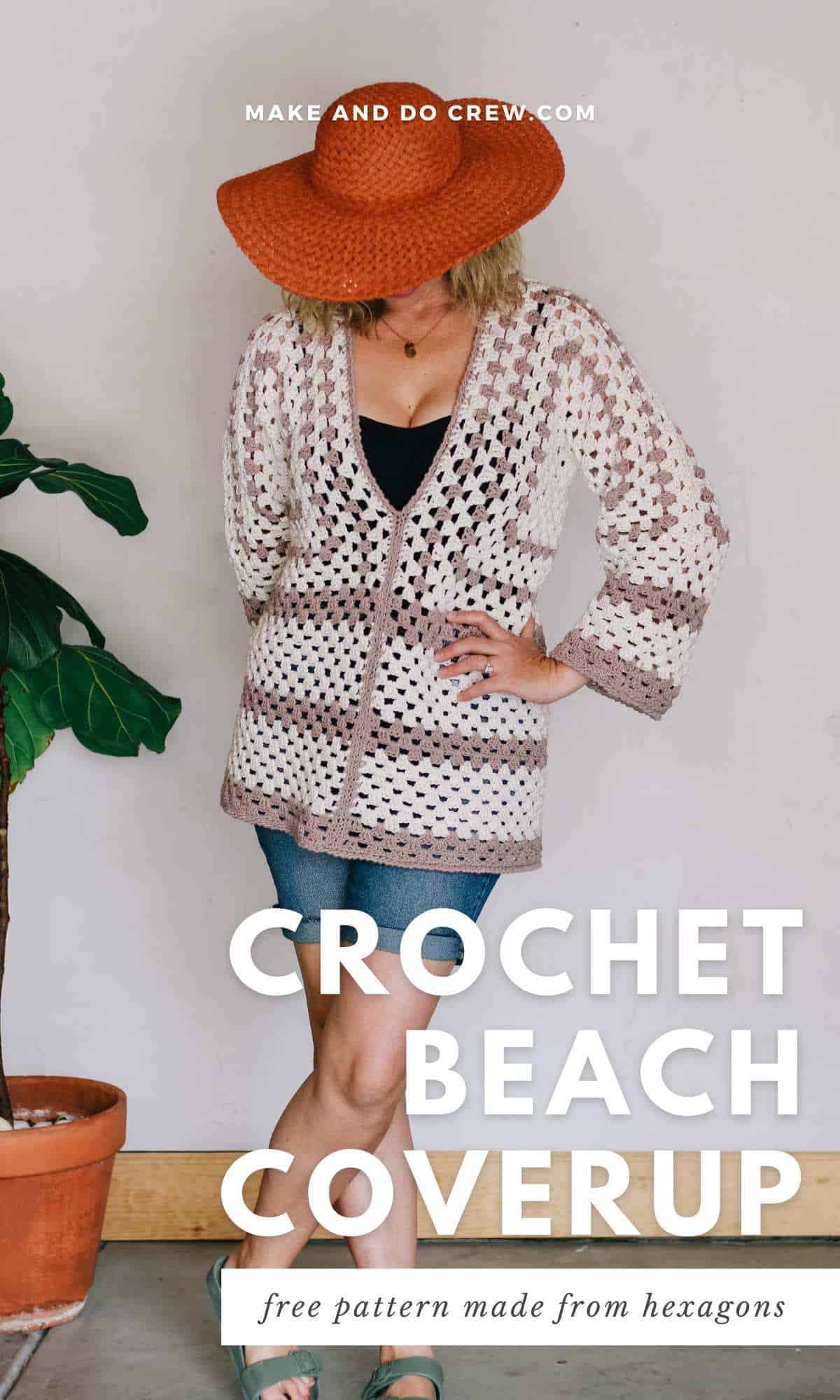
This granny stitch coverup is part of a collaboration with Lion Brand Yarns. This post contains affiliate links.
Jump to:
Coverup Made From Two Crochet Hexagons
Beach coverup or lightweight summer sweater – you decide! You’ll begin by crocheting two identical granny hexagons, which will form the shoulders and chest area of your garment.
Then you’ll tailor this piece to fit your unique body by following the customization notes provided in the pattern.
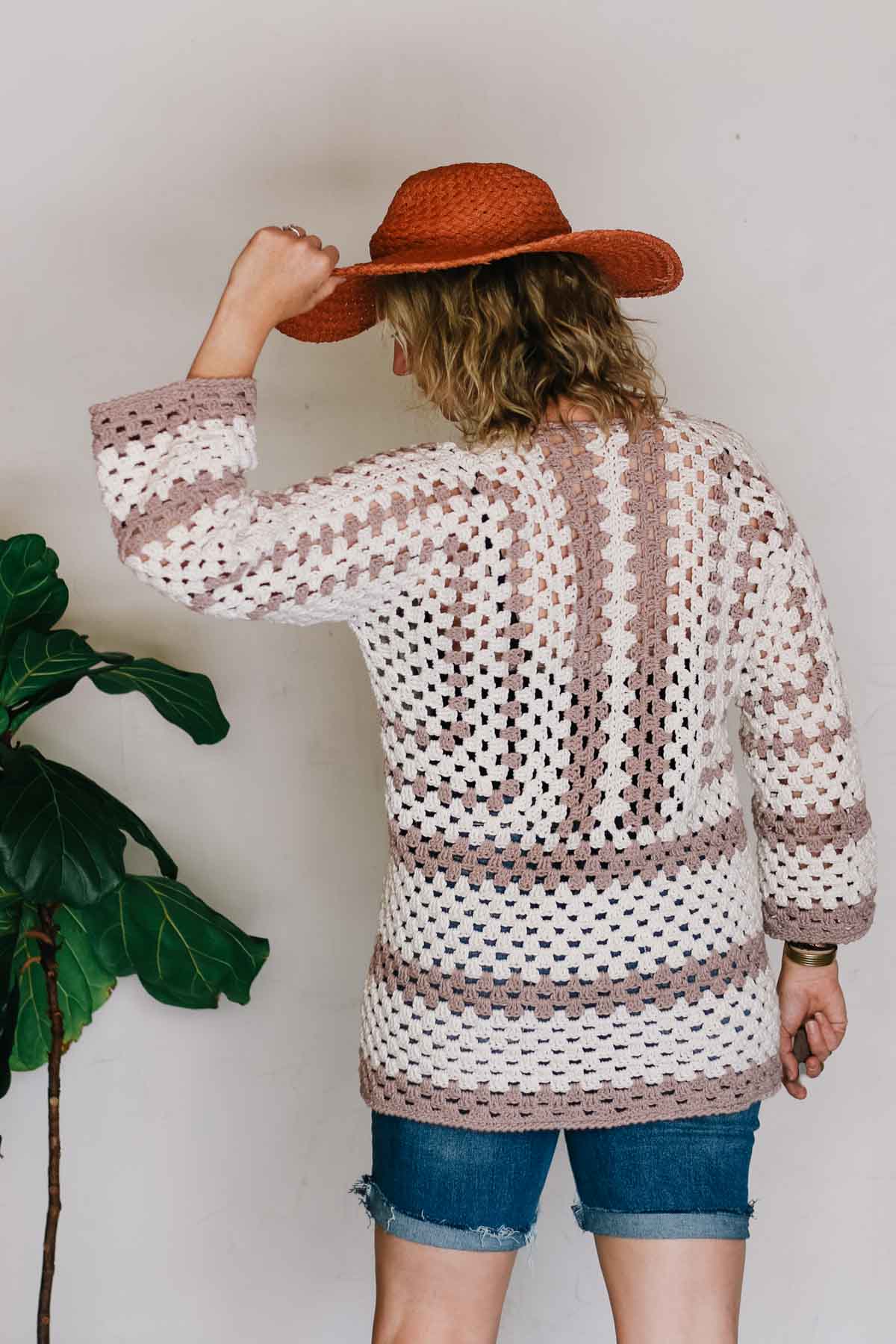
Skills and Techniques
This easy coverup pattern is an excellent choice if you’re new to making clothing because you can try it on as you go. I've included lots of checkpoints in the pattern for you to evaluate and adjust the fit.
Crochet skills you’ll practice include:
- Meeting the pattern gauge
- Double crocheting in the round and rows
- Changing colors (optional)
- Reverse single crochet (aka crab stitch)
What Yarn To Use
For this coverup pattern, we used Lion Brand's Made With Love The Cottony One. This yarn is a collab with Tom Daley, the Olympic diver who also happens to be an awesome knit and crochet artist.
Made With Love is a 60/40 blend of cotton and acrylic and it reminds me a lot of a long discontinued yarn called Lion Brand Cotton Ease. Cotton Ease was one of my favorites to make blankets with, so I'm thrilled this new option exists.
Substitutes
Made with Love is a category 4/medium yarn and should be fairly easy to swap out for another worsted-weight yarn.
Some substitutions I suggest:
- Color Theory
- Heartland
- Check YarnSub.com for other ideas
You'll want to pay close attention to the gauge check instructions in the pattern to decide if you need to use a different hook size. I've found that Made with Love is slightly heavier than some other worsted weight yarns.
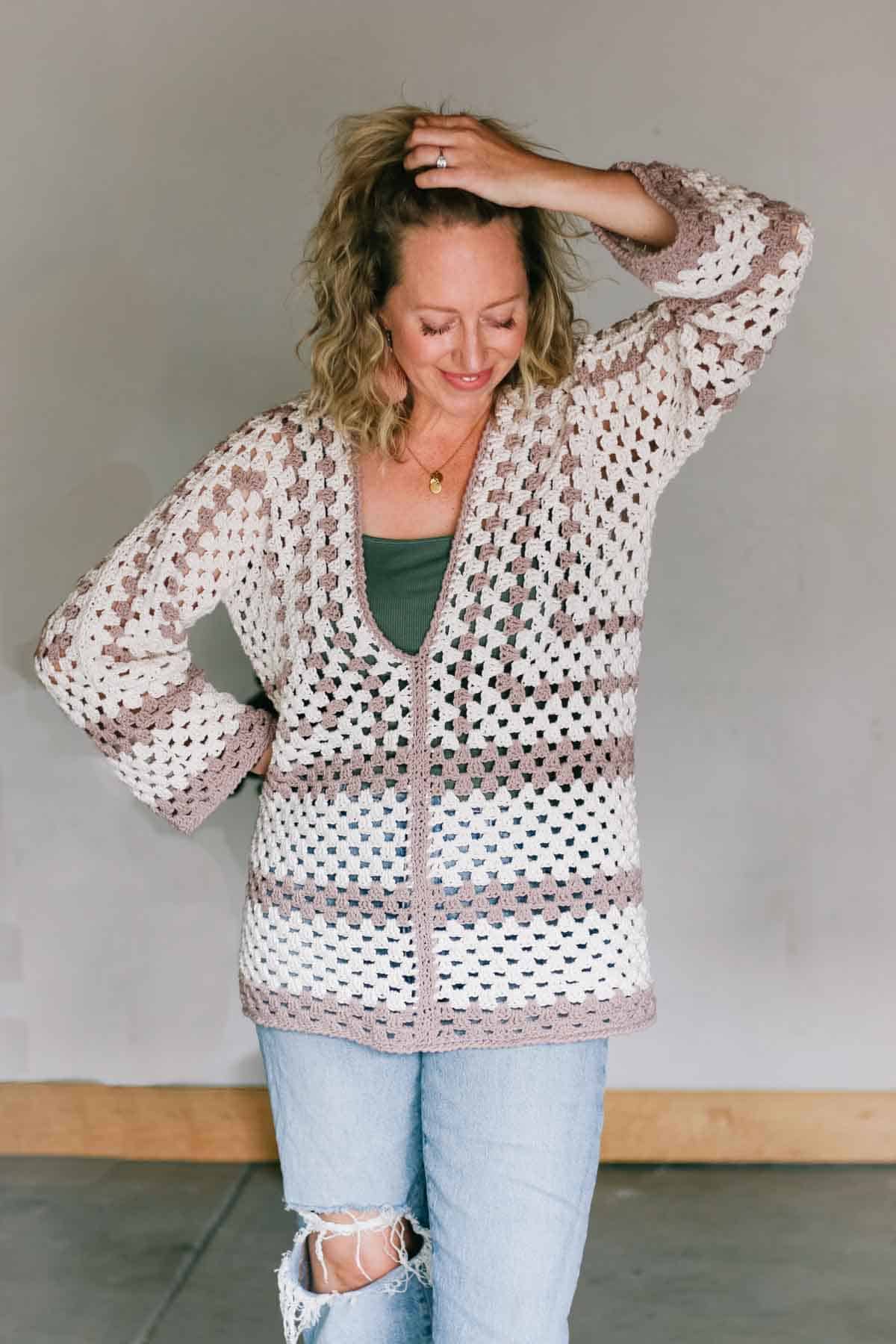
Print This Pattern PDF
Prefer to crochet on the couch? Want all the helpful diagrams and photos? You'll love the premium PDF!
The instantly downloadable, ad-free file is formatted for easy printing and includes the complete pattern, all the photo tutorials, a stitch chart and printable labels for your hexagon sides.
All-in-One Crochet Kit
If you don't live near amazing yarn stores or if you just like to get fun packages in the mail, the all-in-one kit is a perfect way to make your Dune Drifter Coverup. This bundle from Lion Brand includes all the Made With Love yarn you'll need, plus a bonus printable PDF of the pattern (delivered digitally).
More Patterns Made From Hexagons
You may be familiar with our original hexagon sweater pattern, the Campfire Cardigan. Since then we've designed lots more garment patterns that use hexagons as the foundation. If you like this method of construction, don't miss our other crochet hexagon sweater patterns.
Dune Drifter Beach Coverup - Free Pattern
Supplies and Materials
Order an all-in-one kit from Lion Brand.
• Lion Brand Made With Love The Cottony One (Weight 4/ medium 185 yds, 3.5 oz)
Color A: Lychee White (3040-098BB) - 5 (5, 6, 6, 7, 8, 8, 9) skeins (approx. 457 (494, 523, 581, 639, 711, 799, 908) g)
Color B: Marvelous Mushroom (3040-122AF) - 3 (3, 3, 3, 4, 4, 4, 5) skeins (approx 229 (247, 261, 290, 319, 356, 399, 454) g)
• Size K (6.5 mm) crochet hook or size needed to obtain gauge
• Stitch markers or safety pins
• Tapestry needle
• Blocking Board (optional)
• Steamer or iron with steam functionality
• T-pins for blocking
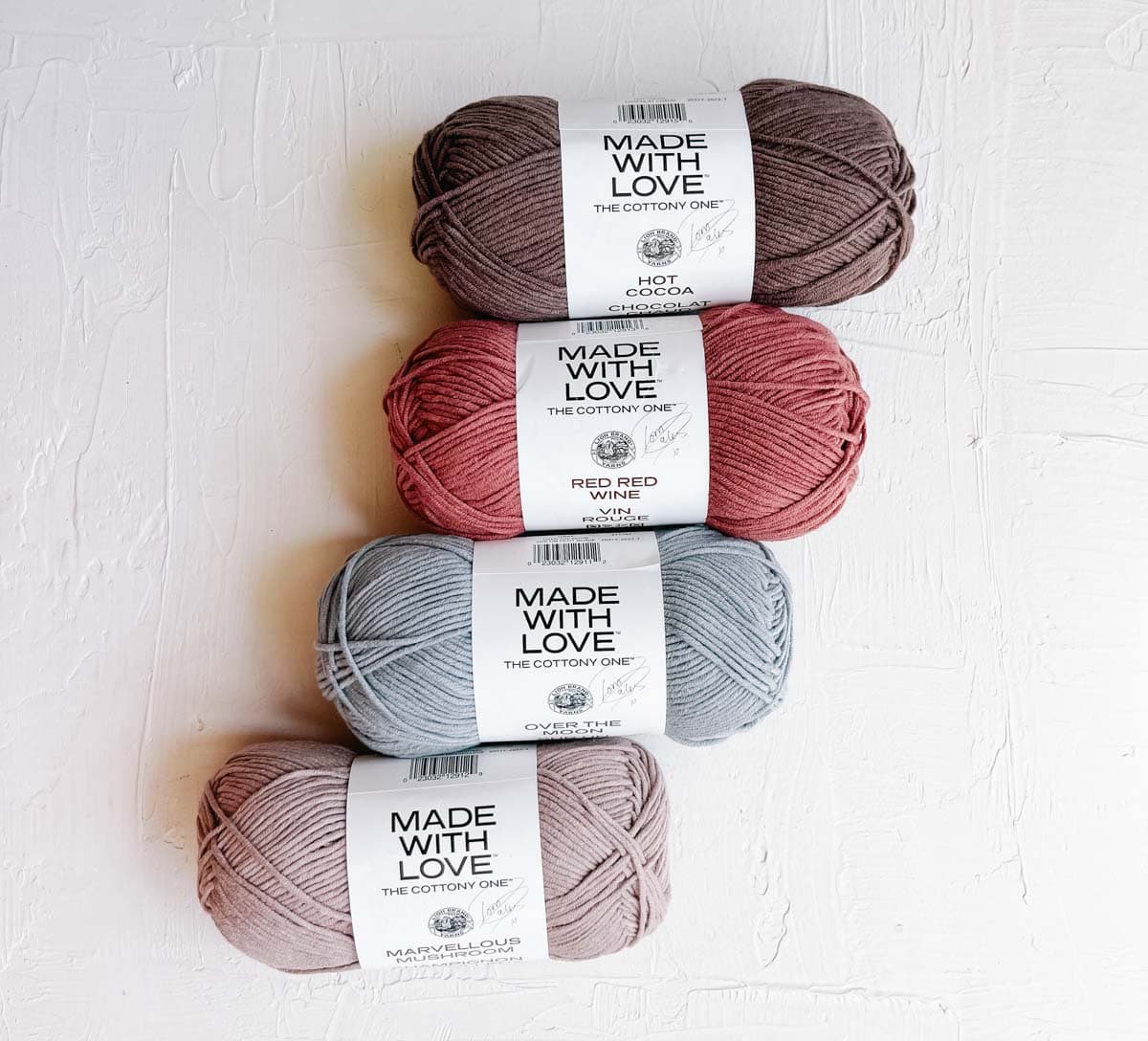
Sizes and Measurements
This pattern is offered in eight total sizes, including plus sizes.
| Size | Fits Actual Bust** | Coverup Length* | Chest Width* |
| XS/S | 31” | 26” | 17” |
| S/M | 35” | 28” | 19.5” |
| M/L | 39” | 28” | 22” |
| L/1X | 43” | 30” | 24” |
| 1X/2X | 47” | 30” | 26.5” |
| 2X/3X | 51” | 30” | 28.5” |
| 3X/4X | 55” | 31” | 31” |
| 4X/5X | 59” | 31” | 33” |
* Measured laying flat.
** If between two sizes, size up or down based on how you’d like your coverup to fit. As written, it’s quite oversized. For a more fitted coverup, size down.
Gauge
4 granny clusters + 4 spaces = 4”
7 rounds = 4” worked in double crochet granny stitch
Abbreviations and Glossary (US Terms)
blo – back loop only
ch – chain
chsp – chain space
cluster – 3 double crochet in same space
dc – double crochet
hdc – half double crochet
rep – repeat
rsc – reverse single crochet (crab stitch)
RS – right side
sc – single crochet
slst – slip stitch
tch – turning chain
WS – wrong side
yo – yarn over
Video Tutorials
Watch relevant video tutorials for portions of the pattern here or check out my hexagon cardigan tutorials on Youtube.
Helpful Resources + Tutorials
If you're new to learning how to crochet, check out these beginner guides that will level-up your skills.
- Crochet Supplies - what to buy and what you can skip
- How to Read Crochet Patterns - tackle your next project with confidence
- How to Check Your Crochet Gauge - skipping this step is a common beginner mistake
- How to Weave in Your Ends - make this necessary evil less painful with these tips
- Blocking Your Crochet - why it matters and how to do it
Skill Level
This coverup is an easy-level project. You should have some experience with crochet before beginning, but this is a great pattern to make your first garment.
Permissions + Copyright:
Please do not publish or share this pattern as your own. You may make items to sell with this pattern. In exchange, please link back this post. Do NOT use our photos as your own sales photos.
Overall Pattern Notes
- Instructions are written with the stitch count for the smallest size first and each larger size following in parentheses, for example: XS/S (S/M, M/L, L/1X, 1X/2X, 2X/3X, 3X/4X and 4X/5X). It can be very helpful to highlight the numbers for your size before beginning the project. When only one number is given, it pertains to all sizes.
- Stitch counts at the end of each round are for given sizes.
- You can easily adjust the size of this coverup to suit your body. To make a smaller version, crochet smaller hexagons. To make a looser coverup, crochet larger hexagons. Notes are given throughout on further customizations.
- Ch 3 at beginning of round/row counts as 1 dc throughout the pattern.
- Instructions refer to different sides of the hexagon by number, which is illustrated in the chart below. Think of these side numbers as fixed to the hexagon, regardless of orientation. For example, Side 3 is always Side 3, whether you flip the hexagon over or stand on your head. Side 3 does not become Side 5, just because the hexagon is flipped to the wrong side.
- When you measure your gauge after Round 7, please pin name tags to each hexagon side. This will ensure you can easily identify hexagon locations as described. (If you're working from the premium pattern, you have printable tags in your PDF.)
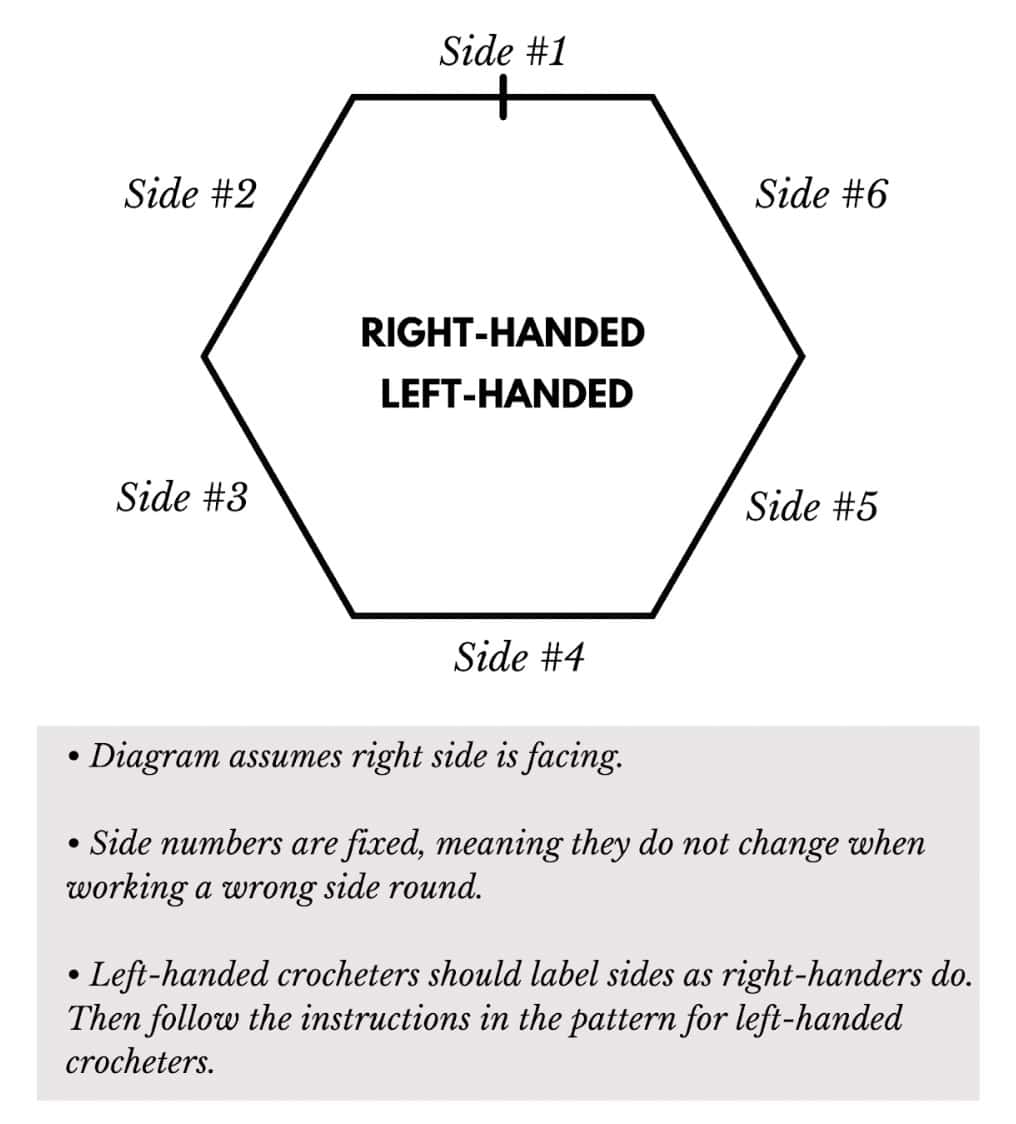
Advice for Planning Your Stripes
It can be helpful to think ahead about what you’d like your striping pattern to look like. We’re providing what was used in the sample pictured (size M/L), but don’t be afraid to create your own look.
Hexagon:
Rounds 1-7: Color A
Round 8: Color B
Rounds 9-11: Color A
Round 12: Color B
Rounds 13-14: Color A
Front + Back Extensions:
Rows 1-2: Color A
Rows 3-5: Color B
Bottom Extension:
Row 1: Color A
Rows 2-4: Color B
Rows 5-11: Color A
Rows 12-14: Color B
Rows 15-21: Color A
Rows 22-24: Color B
Sleeve Extension:
Row 1-3: Color A
Rows 4-6: Color B
Rows 7-11: Color A
Rows 12-14: Color B
Print This Pattern: purchase the ad-free, printable PDF
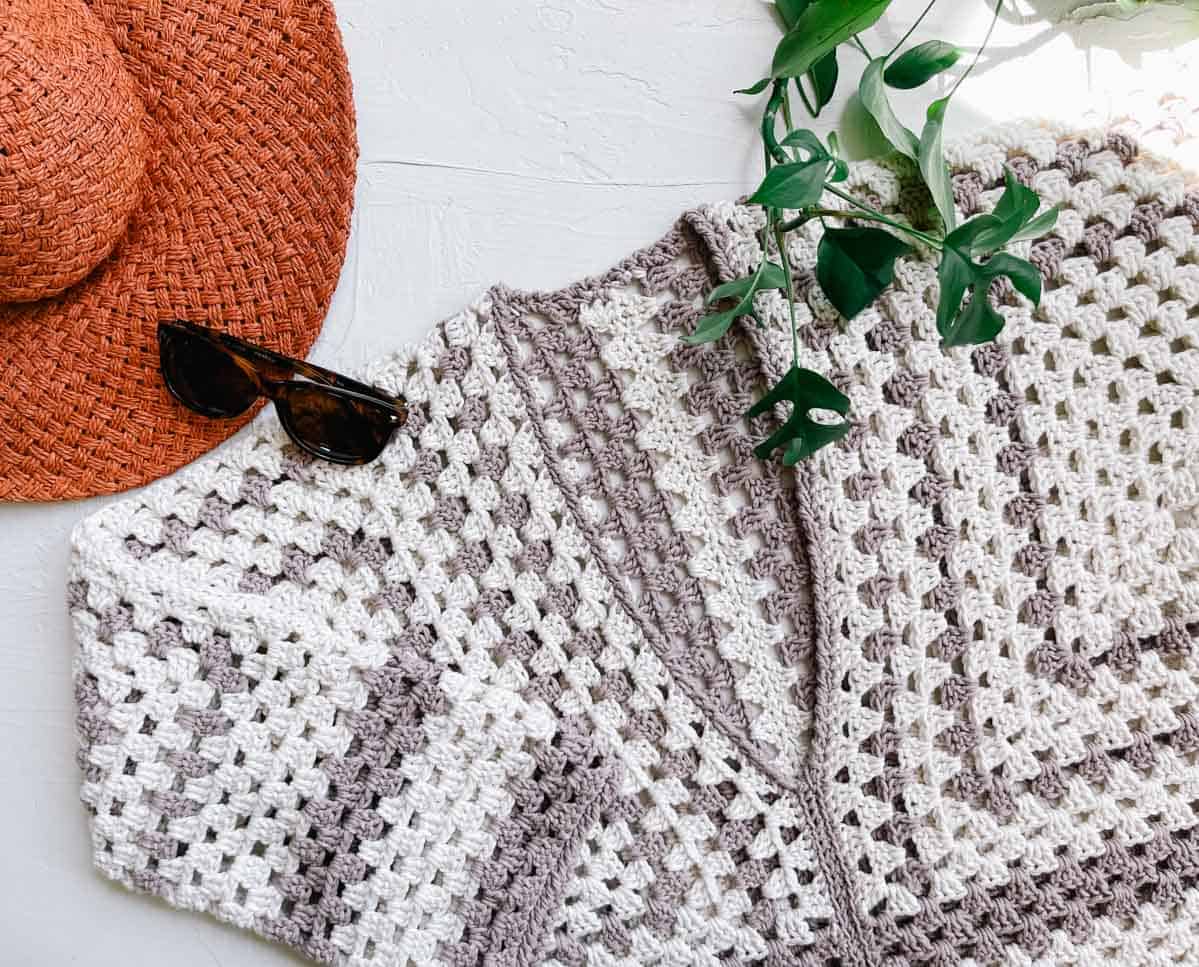
Hexagons
Notes:
- Hexagon is worked in turned rounds.
- After a few rounds, hexagon will look wavy and should not be able to lay flat. This is intentional to create enough fabric for the body and sleeves.
- Corner spaces will always be made of 3 chains. Spaces along the sides of the hexagon will be made with 1 chain.
- When switching colors for a new round, use the new color to complete the final yarn over of the round you’re finishing. Fasten off previous color. Turn your work and proceed with new color in the next round.
- Here is my video tutorial on crocheting the main hexagons:
Make 2.
Preferred Foundation: Create a magic ring.
Alternate Foundation: Ch 4 and slst to first ch to form a ring.
Round 1 (RS): Ch 3, 2 dc in ring, ch 1, (3 dc in ring, ch 1) 5 times, slst to top of ch 3 to join; turn. (6 sides, 1 cluster/side)
Round 2 (WS): Ch 3, (2 dc, ch 3, 3 dc) all in first ch1sp, ch 1, [(3 dc, ch 3, 3 dc, ch 1) all in next ch1sp] five times, slst to top of ch 3 to join; turn. (2 clusters/side)
Round 3 (RS): Ch 3, 2 dc in next ch1sp, ch 1, [(3 dc, ch 3, 3 dc) all in next ch3sp, ch 1, 3 dc in next ch1sp, ch 1] five times, (3 dc, ch 3, 3dc) all in next ch3sp, ch 1, slst to top of ch 3 to join; turn. (3 clusters/side)
Round 4 (WS): Ch 3, 2 dc in next ch1sp, ch 1, [(3 dc, ch 3, 3 dc) all in next corner ch3sp, ch 1, (3 dc, ch 1) in each ch1sp to corner] six times, ch 1, (3 dc, ch 1) in each ch1sp to end of round, slst to top of ch 3 to join; turn. (4 clusters/side)
Round 5 (RS): Rep Round 4. (5 clusters/side)
Round 6 (WS): Rep Round 4. (6 clusters/side)
Round 7 (RS): Rep Round 4. (7 clusters/side)
Premium PDF
easier and faster with fewer mistakes.
- Complete pattern + photo tutorials
- Instant download
- Formatted for easy printing
!! Gauge Check !!
Please stop and take a minute to measure your hexagon. This will ensure your coverup is the size you expect it to be. Measure from the center of the hexagon to the center of the edge on one side (radius). This should measure 4”.
Measure several sides of the hexagon. Each side should measure 7-7.5”. If your hexagon radius or each side length is too large, decrease your hook size and rework hexagon. If your hexagon radius is too small or each side length is too small, increase your hook size and rework hexagon.
Once correct gauge is established, lay hexagon flat with RS facing up. (Last round worked was a RS round.) Use stitch markers to pin side-number name tags to each side according to the chart above.
Rounds 8-12 (14, 14, 16, 16, 16, 18, 18): Rep Round 4. Hexagon should now contain 12 (14, 14, 16, 16, 16, 18, 18) rounds. Final round should have 12 (14, 14, 16, 16, 16, 18, 18) clusters per side and measure approximately 7 (8, 8, 9, 9, 9, 10, 10)” from center of hexagon to middle of one of the edges.
Want some company while you crochet?
Get support (and camaraderie!) in the Make & Do Crew community. Join for free here.
Back + Front Extensions
Extra rows are now worked along specific sides on each hexagon to extend fabric that will form the center back and center front of the coverup.
- To switch colors at the end of a row, use the color of the upcoming row to complete the final yarn over of the row you’re finishing. Fasten off previous color. Proceed with new color in the next row.
Watch a video tutorial here on how to add granny stitch extensions to the hexagon sides below:
Left Side of Coverup as Worn
Notes:
- Back = side #5, Bottom = side #4, Front = side #3
- Chain 4 counts as 1 double crochet + 1 chain space.
Back Extension
You will work along Side #5 only.
Right-handed crocheters: Attach yarn in ch3sp corner between Sides #4 and #5. Left-handed crocheters: Attach yarn in ch3sp corner between Sides #5 and #6.
Row 1 (RS): Ch 3, 2 dc in same ch3sp, *ch 1, 3 dc in next ch1sp; rep from * along side until only corner remains, ch 1, 3 dc in corner ch3sp; turn. (13 (15, 15, 17, 17, 17, 19, 19) clusters) Row 2 (WS): Ch 4, *3 dc in next ch1sp, ch 1; rep from * along side until 1 cluster remains, dc in top of tch; turn. (12 (14, 14, 16, 16, 16, 18, 18) clusters + 2 dc)
Row 3 (RS): Ch 3, 2 dc in first ch1sp, *ch 1, 3 dc in next ch1sp; rep from * along side until 1 cluster remains, ch 1, 3 dc in last ch1sp; turn. (13 (15, 15, 17, 17, 17, 19, 19) clusters)
Rep Rows 2 and 3 - (-, one, one, two, three, three, four) more times. Fasten off leaving a long tail for seaming.
Back extension should now contain 3 (3, 5, 5, 7, 9, 9, 11) rows.
Front Extension
You will work along Side #3 only.
Right-handed crocheters: Attach yarn in ch3sp corner between Sides #2 and #3. Left handed crocheters: Attach yarn in ch3sp corner between Sides #3 and #4.
Repeat instructions for Left Back Extension, but work only 1 (1, 3, 3, 5, 7, 7, 9) rows total. This should result in two fewer rows than Back Extension. Fasten off.
Right Side of Coverup as Worn
Notes:
- Back = Side #3, Bottom = Side #4, Front = Side #5
- Chain 4 counts as 1 double crochet + 1 chain space.
Back Extension
You will work along Side #3 only.
Right-handed crocheters: Attach yarn in ch3sp corner between Sides #2 and #3. Left-handed crocheters: Attach yarn in ch3sp corner between Sides #3 and #4.
Row 1 (RS): Ch 3, 2 dc in same ch3sp, *ch 1, 3 dc in next ch1sp; rep from * along side until only corner remains, ch 1, 3 dc in corner ch3s; turn. (13 (15, 15, 17, 17, 17, 19, 19) clusters)
Row 2 (WS): Ch 4, *3 dc in next ch1sp, ch 1; rep from * along side until 1 cluster remains, dc in top of tch; turn. (12 (14, 14, 16, 16, 16, 18, 18) clusters + 2 dc)
Row 3 (RS): Ch 3, 2 dc in first ch1sp, *ch 1, 3 dc in next ch1sp; rep from * along side until 1 cluster remains, ch 1, 3 dc in last ch1sp; turn. (13 (15, 15, 17, 17, 17, 19, 19) clusters)
Rep Rows 2 and 3 - (-, one, one, two, three, three, four) more times. Fasten off leaving a long tail for seaming.
Wanna save this pattern?
Back extension should now contain 3 (3, 5, 5, 7, 9, 9, 11) rows.
Front Extension
You will work along Side #5 only.
Right-handed crocheters: Attach yarn in ch3sp corner between Sides #4 and #5.
Left handed crocheters: Attach yarn in ch3sp corner between Sides #5 and #6.
Repeat instructions for Right Back Extension, but work only 1 (1, 3, 3, 5, 7, 7, 9) rows total. This should result in two fewer rows than Back Extension. Fasten off.
Obsessed with finding the best free crochet patterns?
Check out these collections of handpicked patterns to find your next project.
Fit Check
Try On Time!
The simple seaming process that follows is a great opportunity to try your hexagons on and check the fit of your coverup so far. To do this, follow all the folding and pinning instructions below, but do not actually sew the pieces together before trying them on.
Note that the circumference at the hips will match the current bust circumference. If you’re happy with the fit, carry on with seaming. If you’d like to adjust the fit slightly, here’s how to do it:
To make your coverup fit tighter at bust and hips:
Remove an even number of rows of the Back Extensions (and the same number from the Front extensions). For example, you might remove 2 rows from the Back and Front Extensions on both hexagons. This would reduce the overall circumference of the coverup bust by about four inches.
To make your coverup bust fit looser at bust and hips:
Add an even number of rows of the Back Extensions (and the same number to the Front extensions). For example, you might add 2 rows to the Back and Front Extensions on both hexagons. This would increase the overall circumference of the coverup bust by about four inches.
Note: As with any time you adjust a given pattern, making changes here will affect the stitch counts in other sections of your garment. (Namely your Bottom Extensions.) This shouldn’t create too much confusion, but I want you to have a heads up ahead of time.
Also, making sizing adjustments like this may affect the amount of yarn needed to complete your project.
Joining Hexagons
Now, we're going to join the two hexagons into the top of our coverup sweaters. Watch a video tutorial on how to seam them here:
To Fold and Create the Sleeves:
The following instructions are to be completed on one hexagon at a time. With RS facing together, use stitch markers to pin Sides #2 and #6 together (and Front + Back Extensions).
Take care to line up clusters on either side of hexagon sides. Pin in place using stitch markers. Folded hexagon should now resemble an “L” shape.
Using a tapestry needle and the same color yarn used in your last hexagon round, sew sleeve seam from the hexagon edge (elbow area) toward shoulder using the mattress stitch. Continue seaming Front and Back Extensions together until all Front rows are joined to Back.
Repeat with second hexagon.
To Join the Back Extensions:
With RS still facing in, lay hexagons next to each other so back extensions are touching. Pin in place, taking care to line up clusters on either side of extensions.
Using a tapestry needle and existing yarn tail, sew back seam using the mattress stitch.
Bottom Extension
Notes:
- When working Round 1, you will crochet along bottom hexagon Sides #4 as well as along the raw row edges of the Back and Front extensions. To crochet into the edges of the Extensions, you will work into each row edge that begins with a chain 4. You will skip the row ends that begin with a cluster. This will make more sense as you’re crocheting the row.
- To switch colors at the end of a row, use the color of the upcoming row to complete the final yarn over of the row you’re finishing Fasten off previous color. Proceed with next color.
Right handed crocheters: With RS of coverup facing, attach yarn at what will be the bottom front left corner.This is the ch3sp between sides #3 and # 4 on the left hexagon.
Left handed crocheters: With RS of coverup facing, attach yarn at what will be the bottom, front right corner. This is the ch3sp between sides #4 and #5 on the right hexagon.
Row 1 (RS):
Getting Started (all sizes): Ch 4, 3 dc in next ch1sp…
Along first front extension: *sk next extension row edge, ch 1, 3 dc in next extension row edge; rep from * along bottom of front extension
Along first hexagon side: *ch 1, 3 dc in next ch1sp; rep from * along bottom of hexagon, 3 dc in hexagon corner ch3sp…
Along Front/Back extensions: *sk next extension row edge, ch 1, 3 dc in next extension row edge; rep from * along bottom of extensions (ch 1 over the seam that joins the extensions), sk last extension row edge…
Along second hexagon side: ch 1, 3 dc in corner ch3sp, *ch 1, 3 dc in next ch1sp; rep from * along bottom of hexagon, 3 dc in hexagon corner ch3sp…
Along second front extension: *sk next extension row edge, ch 1, 3 dc in next extension row edge, rep from * along bottom of front extension until one cluster
remains, ch 1, dc in last row edge of front extension; turn. (31 (35, 39, 43, 47, 51, 55, 59) clusters + 2 dc)
Row 2 (WS): Ch 3, 2 dc in same ch1sp (1 cluster made), *ch 1, 3 dc in next ch1sp; rep from *until 1 cluster remains, ch 1, 3 dc in last ch1sp; turn. (32 (36, 40, 44, 48, 52, 56, 60) clusters)
Row 3 (RS): Ch 4, 3 dc in next ch1sp, (ch 1, 3 dc) in each ch1sp until one cluster remains, ch 1, dc in last ch1sp; turn. (29 (33, 37, 41, 45, 49, 53, 57) clusters + 2dc)
Rep Rows 2 and 3 ten (ten, ten, ten, ten, ten, nine, nine) more times. Repeat Row 2 once more. Bottom Extension should now contain 24 (24, 24, 24, 24, 24, 22, 22) rows and end with a WS row.
You can try on your coverup here and evaluate the length. If you are happy with the length proceed to next section leaving yarn attached to work border.
For a shorter coverup: Eliminate rounds in the above section.
For a longer coverup or crocheted dress: Work additional rounds in the above section.
Our Latest Crochet Inspiration:
Here are a few more free crochet patterns and tutorials that are hot off the presses.
Front Border and Seaming
With RS facing and Color B attached yarn:
Set-Up Row:
Similar to a collar, this edging is worked along the entire front edges of the “cardigan” to prepare them for a cleaner seam.
As you progress along the raw row edges of the Bottom Extensions, you will be working into the side of the double crochet stitches and chain spaces. On the Front Extensions you will work into each stitch and chain space.
The right side should be facing while you work this row.
To Work Along Bottom Extensions: Ch 2, hdc in side of dc, 2 hdc in chsp, *2 hdc in side of next dc, 2 hdc in chsp, rep from * to end of bottom extension…
To Work Along Front Extensions: *Hdc in chsp, 1 hdc in each dc of granny cluster, rep from * around neck edge and down front extension of right front (as worn)...
When you’ve crocheted around and ended on the bottom corner of the opposite side you started on, fasten off leaving a 30” tail for seaming the right and left fronts.
To Join the Fronts:
With RS facing in, pin right and left front sections together, leaving approximately 12.5” unpinned for neck opening. This is a great time to try on your coverup and assess the neckline. Seam more or less based on how low you prefer the V-neck.
Using a tapestry needle and existing yarn tail, sew fronts together using the mattress stitch.
Neck Finishing Edging
Now, we’ll add a reverse single crochet (crab stitch) border around the neckline. While this stitch can feel weird at first, you are indeed supposed to work in the opposite direction as you typically do with single crochet. It’s okay that the stitches will twist, this is intentional.
Right-Handed: With the RS facing, this border will be worked counterclockwise. Left-Handed: With the RS facing, this border will be worked clockwise.
Attach Color B yarn at center back seam.
Row 1 (RS): Ch 1, rsc (Crab Stitch) in first st and in each st around neckline, join with slst to first rsc. Fasten off and weave in ends.
Bottom Finishing Edging
Attach Color B yarn along bottom edge of coverup in any ch1sp.
Row 1 (RS): Ch2 (counts as 1 hdc), hdc in each dc of granny cluster and ch1sp around, join with slst to first hdc. Do not turn.
Row 2 (RS): Ch 1, rsc (Crab Stitch) in each hdc around, join with slst to first crab stitch. Fasten off and weave in ends.
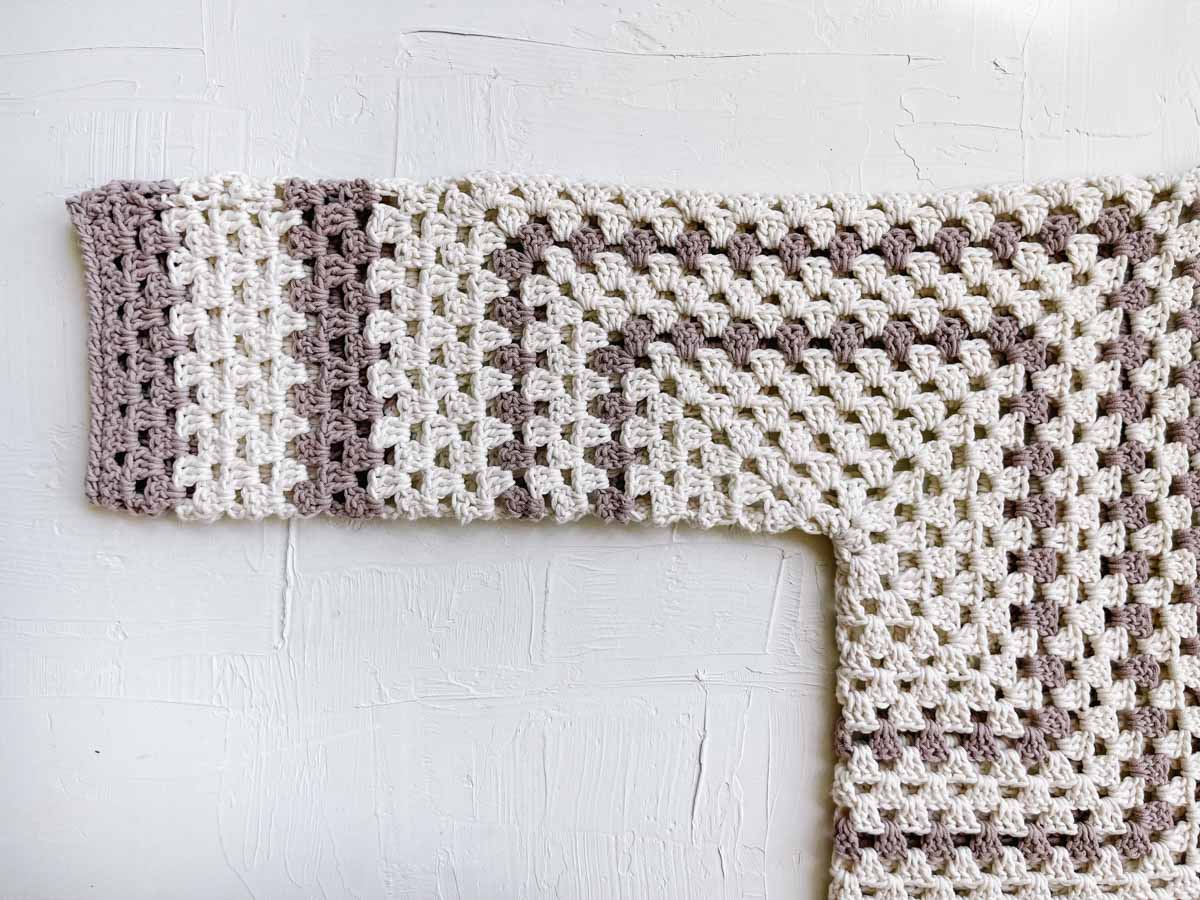
Granny Stitch Sleeves
Notes:
- Sleeves are worked in turned rounds.
- Again, this section is easily customizable to fit your arms. Work fewer rounds for shorter sleeves or extra rounds for longer sleeves.
- When working Round 1, top of sleeve seam where hexagons meet counts as 1 granny cluster. (So work 3 dc into each ch1sp on either side of the seam, chaining 1 in between.)
- The non-tapered sleeve option below does not include decreases, making it ideal for beginners. The wrist opening will be as wide as the current arm opening on your cover up. This creates a more open, bell-style sleeve. This is the version pictured in the sample photos.
Alternatively, the printable PDF also includes instructions for a tapered option to create a more traditional sleeve shape that narrows toward the wrist.
Both Styles of Sleeves:
With RS facing out, lay sweater so shoulder hexagon seam is visible. There will be two hexagon corner spaces at the end of the shoulder seam near the elbow.
One corner space is technically on the front of the coverup and the other is technically on the back of the coverup. You’ll attach your yarn in one of these spaces depending on your dominant hand.
Right and left-handed crocheters: Attach yarn in hexagon corner space on the same side as your dominant hand.
Round 1 is worked with right side of sweater facing out. This means right-handed crocheters will work clockwise. Left-handed crocheters will work counter clockwise.
Non-Tapered Sleeve Option
Make 2.
Round 1 (RS): Ch 3, dc in middle of shoulder seam, dc in next hexagon corner sp (1 cluster made), ch 1, *3 dc in next ch1sp, ch 1; rep from * until end of round, slst to top of ch 3 to join; turn. (12 (14, 14, 16, 16, 16, 18, 18) clusters)
Round 2 (WS): Ch 3, 2 dc in same ch1sp (1 cluster made), ch 1, *3 dc in next ch1sp, ch 1; rep from * until end of round, slst to top of ch 3 to join; turn. (12 (14, 14, 16, 16, 16, 18, 18) clusters)
Round 3 (RS): Ch 3, 2 dc in same ch1sp (1 cluster made), ch 1, *3 dc in next ch1sp, ch 1; rep from * until end of round, slst to top of ch 3 to join; turn. (12 (14, 14, 16, 16, 16, 18, 18) clusters)
Rounds 4-14: Rep Rounds 2-3. To shorten/lengthen sleeves, work fewer or more repeats here.
Edging Set Up Round (RS): Ch2 (counts as 1 hdc), hdc in each st and chsp around bottom of sleeve, join with slst to first hdc. Do not turn. (48 (56, 56, 64, 64, 64, 72, 72) sts)
Final Round (RS): Ch 1, rsc (Crab Stitch) in each hdc around, join with slst to first crab stitch. Fasten off and weave in ends.
Repeat instructions for second sleeve.
Finishing
Weave in remaining ends and admire your hard work. Do a light steam blocking using either a steamer or iron with steam setting. Focus on any areas that aren’t laying quite right, such as the seams or neckline. Learn more about how to block your crochet.
You did it! You’re officially a crochet sorcerer that can turn hexagons into beach attire at the flick of hook.
More Free Sweater Patterns
We have lots more granny square cardigans, easy garments, and fun jumpers for you to try next!
- Nearly Seamless Crochet Cardigan - Easy Free Pattern
- Marika Swancho | A Lacy Crochet Sweater Poncho
- Easy C2C Crochet Cardigan Pattern Made From Rectangles
- Taylor Swift Crochet Dress Pattern | Made From Granny Stitch Hexagons
- Mesh Crochet Pullover Pattern | Quick + Easy
- 27 Easy Crochet Vest Patterns for Year-Round Style
See more cardigan patterns →
That was so fun! Now what?
Invitation to our Facebook group
Come discuss crocheting garments made from hexagons and lots of other projects and techniques in our Make & Do Crew Facebook group. Here thousands of helpful crocheters answer each other's questions and share their stitches. Join us!

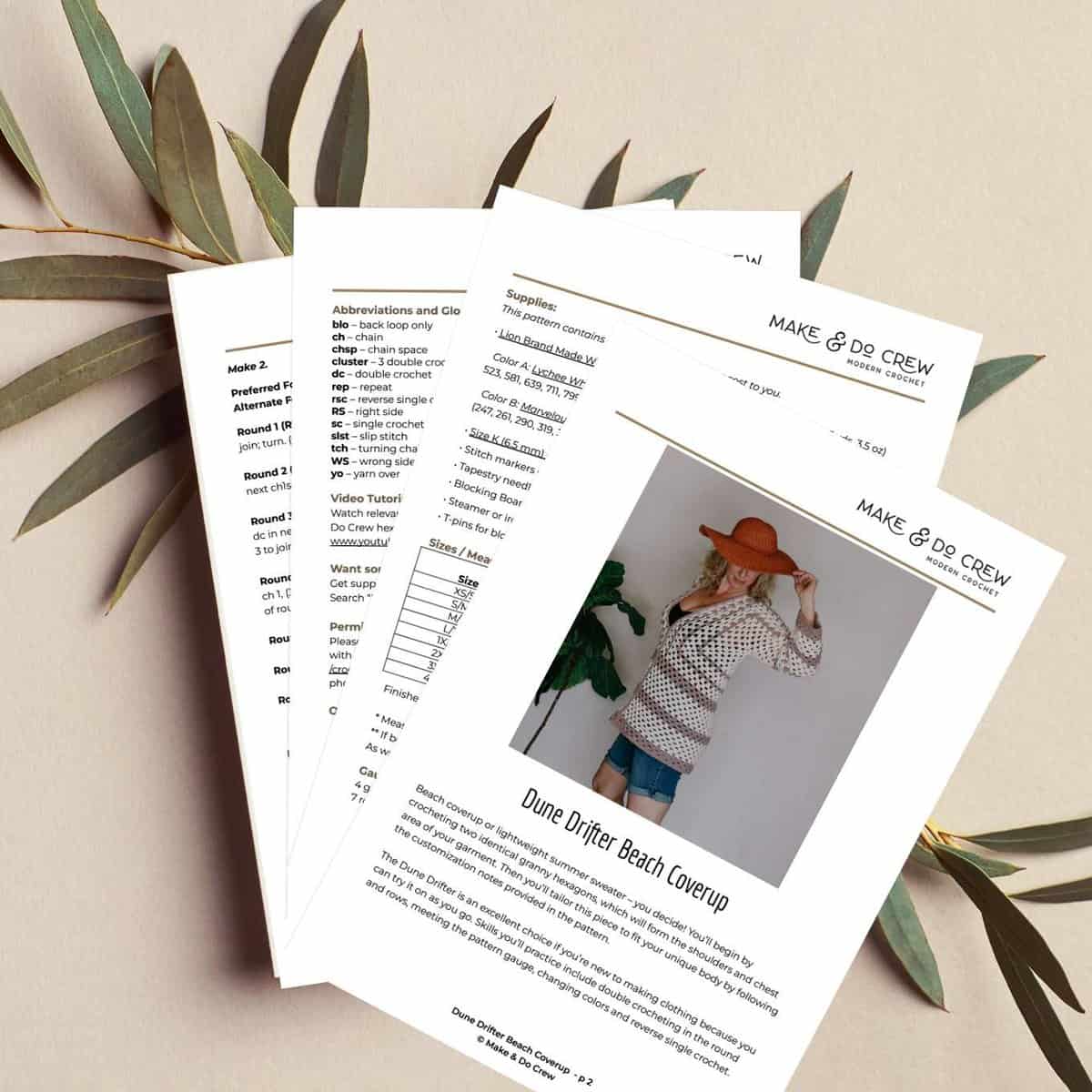


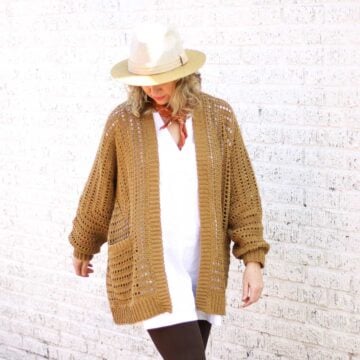
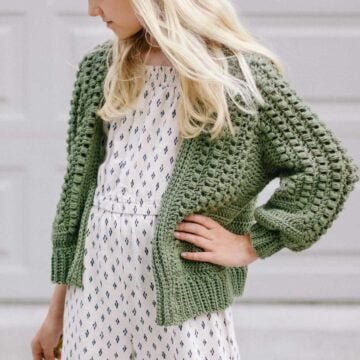
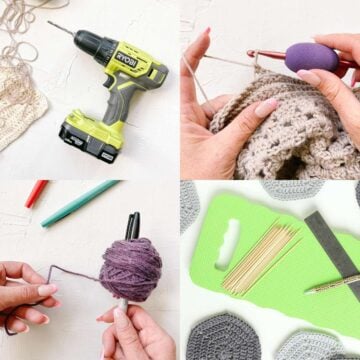
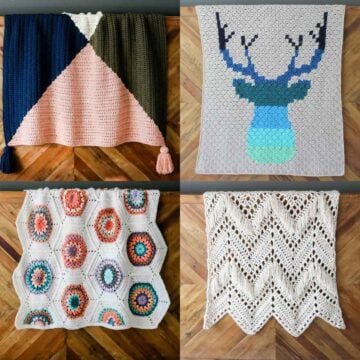

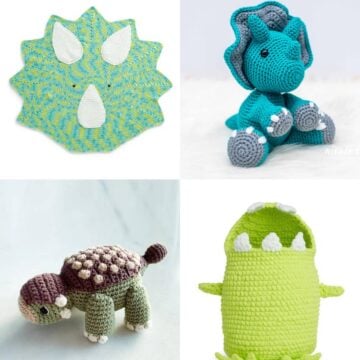
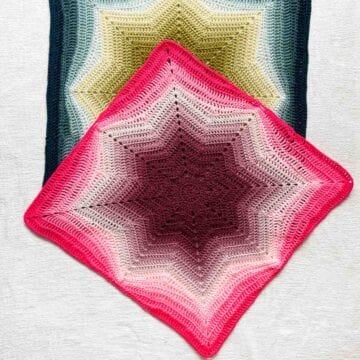
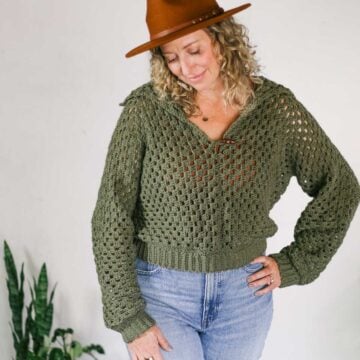
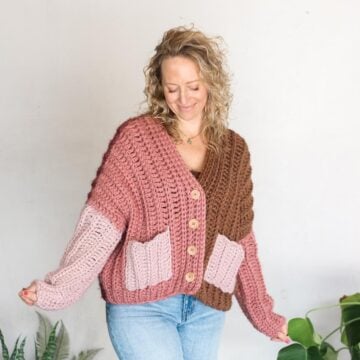

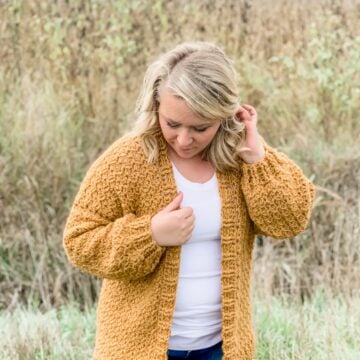
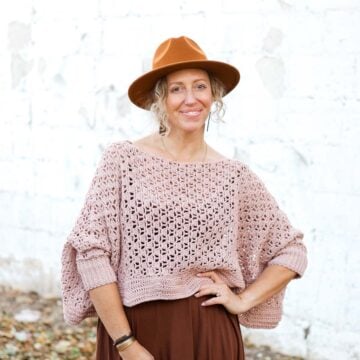

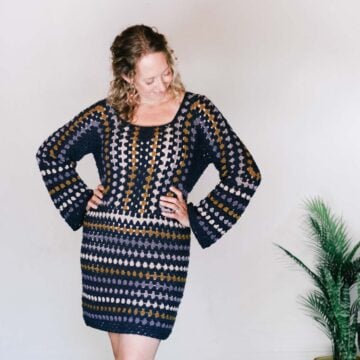
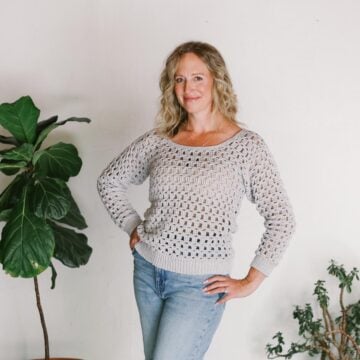
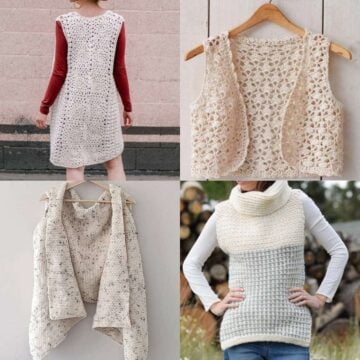
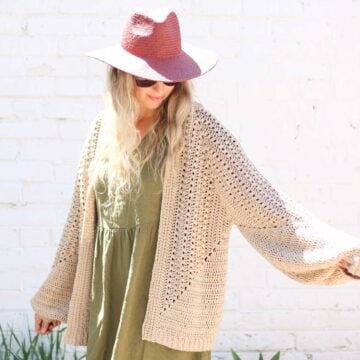

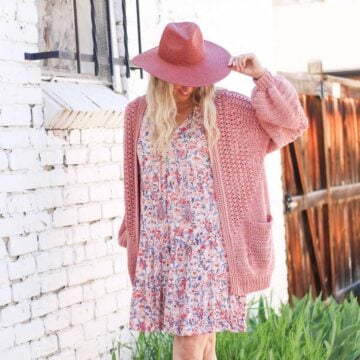
Leave a Reply